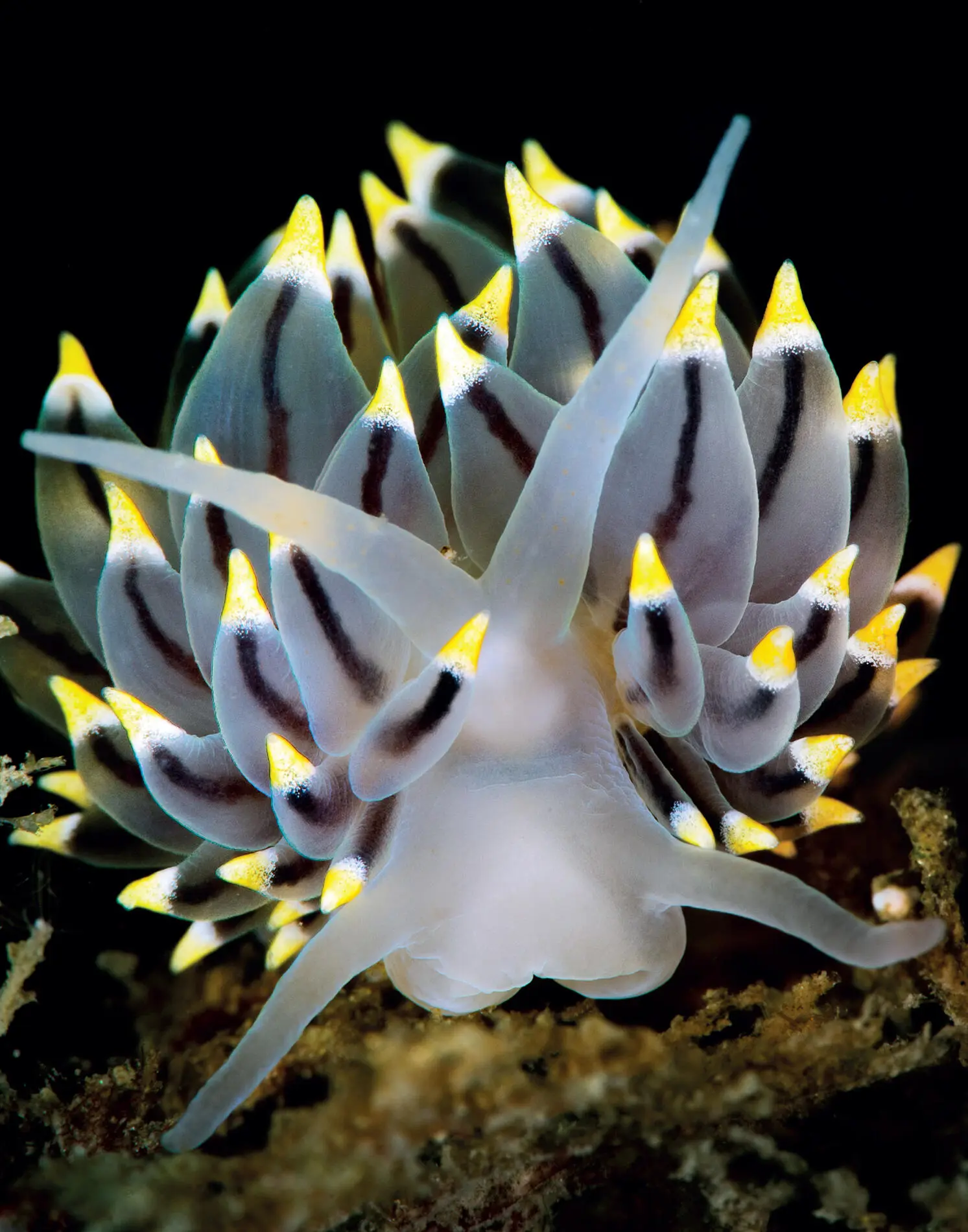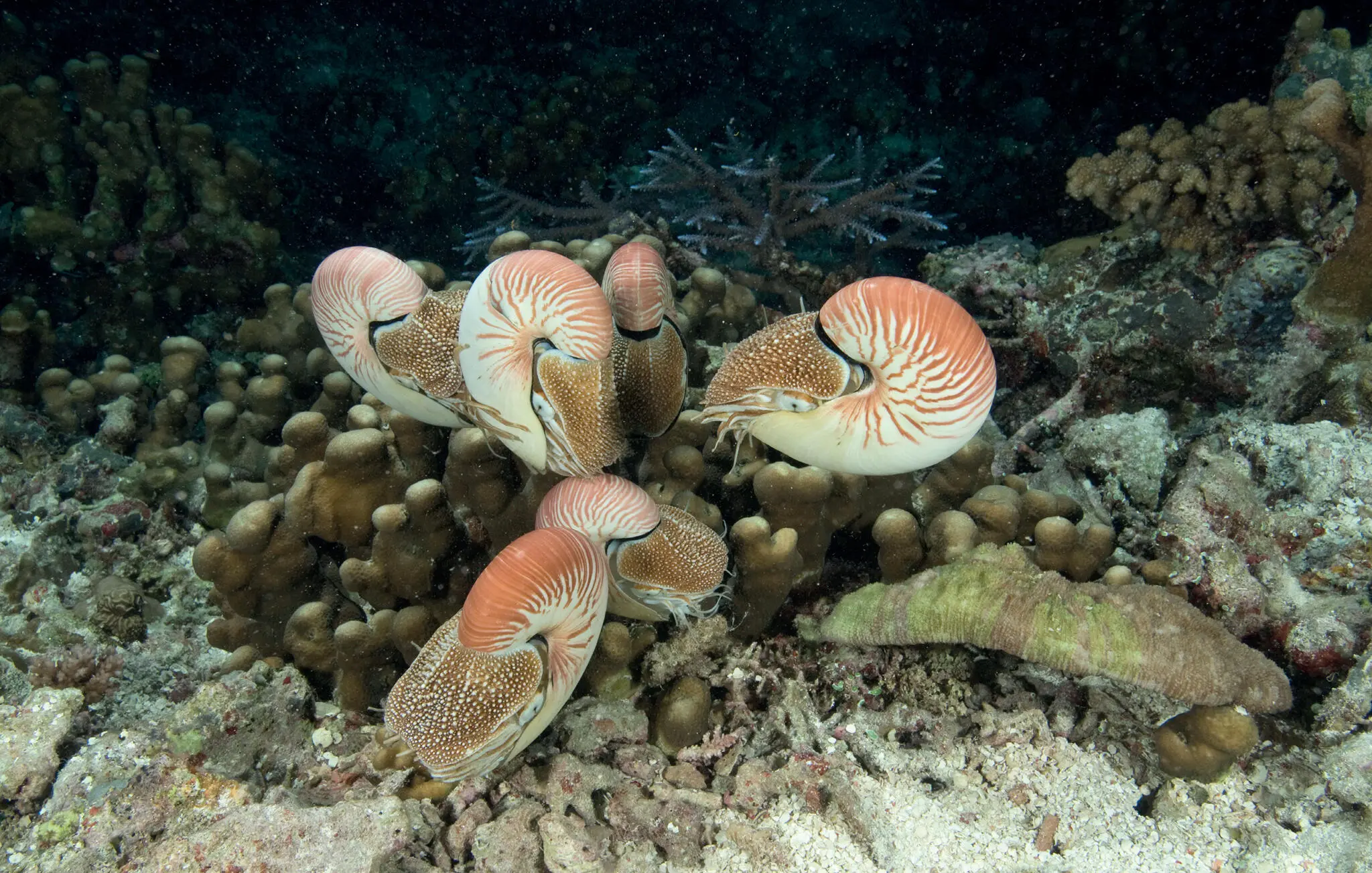1 ...7 8 9 11 12 13 ...20 Some filter feeders like the scallops do manage to travel – by convulsively clapping their valves together and so making curving leaps through the water. By and large, however, adult bivalves live rather static lives and the spreading of the species into distant parts of the seabed is carried out by the young. The molluscan egg develops into a larva, a minuscule animated globule striped with a band of cilia, which is swept far and wide by ocean currents. Then, after several weeks, it changes its shape, grows a shell and settles down. The drifting phase of its life puts it at the mercy of all kinds of hungry animals, from other stationary filter feeders to fish, so in order that its species can survive, a mollusc must produce great numbers of eggs. And indeed it does. One individual may discharge as many as 400 million.
One branch of the molluscs, very early in the group’s history, found a way of becoming highly mobile and yet retaining the protection of a large and heavy shell – they developed gas-filled flotation tanks. The first such creature appeared about 500 million years ago. Its flat-coiled shell was not completely filled with flesh as is that of a snail, but had its hind end walled off to form a gas chamber. As the animal grew, new chambers were added to provide sufficient buoyancy for the increasing weight. This creature was the nautilus, and we can get an accurate idea of how it and its family lived because a few nautilus species, just like Lingulella and Neopilina , have survived to the present day.

A nudibranch ( Eubranchus tricolor ) on the seabed of a Scottish loch.
One of these species, the pearly nautilus, grows to about 20 centimetres across. A tube runs from the back of the body chamber into the flotation tanks at the rear so that the animal can flood them and adjust its buoyancy to float at whatever level it wishes. The nautilus feeds not only on carrion but on living creatures such as crabs. It moves by jet propulsion, squirting water through a siphon in a variation of the current-creating technique developed by its filter-feeding relatives. It searches for its prey with the help of small stalked eyes and tentacles that are sensitive to taste. Its molluscan foot has become divided into some ninety long grasping tentacles which it uses to grapple with its prey. In the centre of them it has a horny beak, shaped like that of a parrot and capable of delivering a lethal, shell-cracking bite.
About 400 million years ago, after some 100 million years of evolution, the nautiluses gave rise to a variant group with many more flotation chambers to each shell, the ammonites. These became much more successful than their nautilus relatives, and today their fossilised shells can be found lying so thickly that they form solid bands in the rocks. Those of some species grew as big as lorry wheels. When you find one of these giants embedded in the honey-coloured limestones of central England or the hard blue rocks of Dorset, you might think that such immense creatures could do little but lumber massively across the seabed. But where erosion has removed the outer shell, the elegant curving walls of the flotation chambers that are revealed remind you that these creatures may well have been virtually weightless in water and able, like the nautilus, to jet-propel themselves at some speed through the water.
About 100 million years ago, the ammonite dynasty began to dwindle. Perhaps there were ecological changes that affected their egg-laying habits. Maybe new predators had appeared. At any rate, many species died out. Other lines gave rise to forms in which the shells were loosely coiled or almost straight. One group took the same path as the sea slugs did in more recent times and lost their shells altogether. Eventually all the shelled forms except the pearly nautilus disappeared. But some shell-less ones survived and became the most sophisticated and intelligent of all the molluscs, the squids and cuttlefish and the octopus. These are the cephalopods.
The relics of the cuttlefish’s ancestral shell can be found deep within it. This is the flat leaf of powdery chalk, the cuttlebone, that is often washed up on the seashore. The octopus has no trace of a shell even within the flesh of its body, but one species, the argonaut, secretes from one of its arms a marvellous paper-thin version shaped very like a nautilus shell but without chambers, which it uses not as a home for itself but as a delicate floating chalice in which to lay its eggs.
The squid and cuttlefish have many fewer tentacles than the nautilus – only ten – and the octopus, as its name makes obvious, has only eight. Of the three creatures, the squids are much the more mobile and have lateral fins running along their flanks which undulate and so propel the animal through the water. All cephalopods can, like the nautilus, use jet propulsion on occasion.

Several nautilus ( Nautilus pompilius ) on a coral reef at night, Pacific.
Cephalopod eyes are very elaborate. In some ways they are even better than our own, for a squid can distinguish polarised light, which we cannot do, and their retinas have a finer structure, which means, almost certainly, that they can distinguish finer detail than we can. To deal with the signals produced by these sense organs they have considerable brains and very quick reactions.
Some squids grow to an immense size. The aptly named colossal squid lives in the seas around Antarctica. It can reach nearly 100 kilos in weight and measure six metres from the end of its body to the tip of its outstretched tentacles. Its rival for the claim to be the largest species of all is the giant squid. The biggest so far discovered have in fact been slightly smaller and substantially lighter. Although there are records of even larger specimens of this species, it seems that these were not accurate. Nevertheless, we are unlikely to have discovered the biggest individuals of either species, so the record may yet be broken. The eyes of these huge cephalopods are even larger than might be expected. The biggest recorded were 27 centimetres across and are the largest known eyes of any kind of animal, five times bigger, for example, than those of the blue whale. Why the squid should have such gigantic eyes is a mystery.
It could be, however, that they need extremely sensitive eyes to detect the presence of their great enemy – the sperm whale. Squid beaks are often found in the stomachs of sperm whales, and their heads often carry circular scars with diameters that match a squid’s suckers. So there seems little doubt that squids and whales regularly fight in the dark depths of the ocean. Maybe the squids’ huge eyes help them to detect the presence of the only animal big enough to hunt them.
The intelligence of all the cephalopods – octopus, squid and cuttlefish – is well known. Octopus have been observed disguising themselves from an approaching enemy by covering themselves with shells or picking up two halves of a coconut and hiding within. Many species in all three groups have an extraordinary ability to change their colour and shape. They can camouflage themselves by matching almost any environment and also signal to one another with patterns and shapes that sweep across their bodies. A female squid has even been filmed signalling to a male lying alongside her that she is not ready to mate, while at the same time displaying a pattern on the other side of her body to summon another male. Octopus and squid, two of the most advanced animals in the ocean which least resemble human beings, are among the few, it seems, that can rival mammals in their intellectual abilities.
Читать дальше














